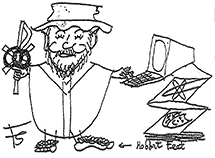Labyrinths are found in many places today: they are usually circular or spiral patterns, with many turns and a centre, and they are for meditative walking. They may be mown in grass or solidified in cement. The most popular form has 11 circles and is copied from a medieval labyrinth in the west end of the Cathedral in Chartres, France.
These labyrinths can be found connected with many churches: there is one near the cemetery in St Mark’s churchyard, King Street, Port Hope, and if you look behind the Eaton Centre in Toronto, near Holy Trinity Church, you will see one in cement, placed there by the City of Toronto and nurtured by that Church. Seven years ago as apart of a Millennial project, eight robed dancers, six women and two men, danced in the St Mark’s labyrinth at the end of the Church service, with music and choreography from Berkeley, California.
I have a similar labyrinth in my lawn just west of Warkworth in Northumberland County, and I started mowing it about 17 years ago, when I had brought the pattern, also from Berkeley. Labyrinths are to be found in prisons, hospitals and many public places. I sit on the Sacred Arts Trust Committee devoted to the use of art in worship which has made grants for ministries based on the quiet journeys people make, walking the labyrinth.
There are patterns of various labyrinths found all over the world. Where did they come from? Almost certainly ancient peoples danced, and danced in circles or in spirals. As they danced they made a pattern on the ground, and this pattern came to be revered like the dance itself. The dance and the pattern were in celebration of fertility, birth, marriage, and celebration of life after death as in a funeral. The labyrinth paths probably functioned inside of or alongside of the stone circles such as Stonehenge or the stone burial barrows in Celtic countries. People perceived a magic in the succession of the seasons and the movement of the sun, moon and stars, just as today we see these through scientific eyes, and observe patterns which can be described by mathematics.
Labyrinths were also representative of the interior of people’s lives. Literally there are labyrinthine patterns in the brain, the ear, in the intestines, in the shells of the seashore, and some parts of the pattern turned up in early alphabets. People saw the following of the pattern in a walk or a dance as conforming with the power of the world and of the soul. Later on the labyrinths were taken over by more sophisticated religions, like Christianity, and built into structures as means of pilgrimage, as in Chartres Cathedral.
Truth of the Way is in the Dance:
those primal forms of joy, of ecstasy and fear,
inscribed upon the earth, defiant of grim chance.
Their spirals lead us in by circles small
to an ampersand of change through which we steer
our course of faith; circle open in the pool,
we ride widening waves, our minds in thrall.
In prime, do all things thrice - the interchange
begins, we circle small again, and divinely fool
both linear time and space - scribe a vasty S
while past us flow our siblings in exchange
of place by place, and foot by foot; then reverse,
never retrace our way, but live in process:
so we transcend the world, whose motions we rehearse.

